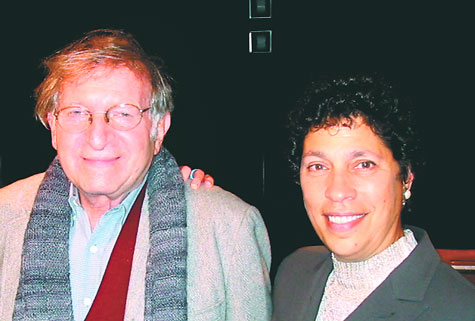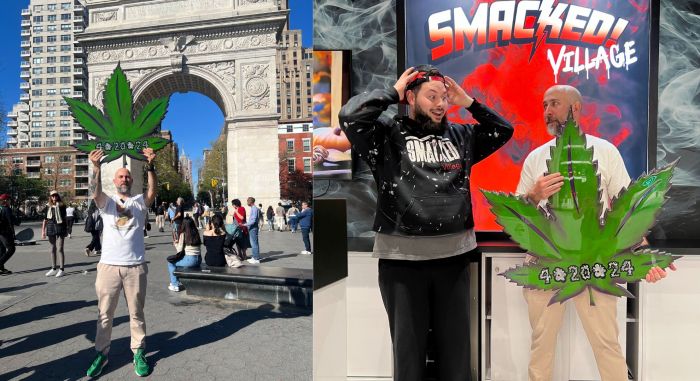VOLUME 3, ISSUE 344 | October 28 – November 3, 2004
THEATER
The World Was In Chicago
Remembering the trial of activists whose dissent defined the ’68 election
Well. Yogi, it was certainly déjà vu all over again at 45 Bleecker Street this past Monday night.
The Chicago 8, who became the Chicago 7 when gagged-and-handcuffed Bobby Seale was separated from the proceedings, were back on trial for conspiring to commit violence on the streets of Mayor Richard J. Daley’s fair city during the Democratic National Convention of 1968.
Only this was 36 years later and the event was the one-night-only reading of a crisp, sharp transcript-based 1979 play called “The Chicago Conspiracy Trial.”
At intermission, a gentleman to my left walked up to Bill Buell, the actor playing the late William J. Kunstler, lead defense attorney of the Chicago 7, and thanked him with: “This brings it all back. Very painful.”
It did, it does, indeed. In the summer of 1968 I had spent an intense week in Chicago—I can still smell the stink bombs in the hotel lobbies and see the big-muscled blue-helmeted police and ranks of young, nervous National Guardsmen everywhere—as one of a team covering that convention for the Dorothy Schiff New York Post. A year later, in September 1969, I was back in Chicago covering the opening of the trial of those eight-minus-one.
I can hear it now. Actually, I heard it then, in Chicago, as I do now again, on Bleecker Street.
ASSISTANT DEFENSE COUNSEL LEONARD WEINGLASS: Abbie Hoffman, prior to coming to Chicago, did you enter into an agreement with David Dellinger, John Froines, Tom Hayden, Jerry Rubin, Lee Weiner, or Rennie Davis, to come to the city of Chicago, for the purpose of encouraging and promoting violence during the convention week?
ABBIE HOFFMAN: An agreement?
WEINGLASS: Yes.
HOFFMAN: We couldn’t agree on lunch.
It was true. At the carnival-sideshow press conferences which the defendants held en masse every day at the lunchtime break in a room somewhere beneath the courtroom of the vaulted Federal Building, each of them took his starring turn, with Abbie, of course, the brightest and funniest—mordantly, savagely funniest—star of all.
I say “vaulted” not because of the architecture of that eminent building but because, for the occasion of this trial of these seven fearsome menaces, Mayor Daley had seen to it that the press, like the spectators, had every day to go several times through a security gauntlet as at a bank vault, or a series of bank vaults. The likes have not been seen since, until—thanks to the events of another September in another American city—the security that is a factor in all our lives today.
The trial may be seen in retrospect, and could be seen even then, as a checkerboard of cultural/ideological one-on-one mortal combats: Hoffman vs. Hoffman; Hoffman vs. Seale; Hoffman vs. Kunstler; Hoffman vs. Weinglass (whose name Hizzoner perpetually got wrong—Weinrus, “Weinstein,” “Feinglass,” or just “Mr. Er…”); and, down in the pit, Foran vs. Kunstler; Foran vs. Weinglass; Schultz vs. Kunstler; Schultz vs. Weinglass.
All of which makes for good drama, perfect drama, as compressed 25 years ago from the five-month trial transcript by California’s Odyssey Theatre playwrights Ron Sossi and Frank Condon; which on Monday was given a reading under the precisioned direction of tall, young David Travis as a fund-raiser for his Synapse Productions.
Foran was U.S. Attorney Thomas Aquinas Foran, chief prosecutor. Schultz was Richard G. Schultz, assistant prosecutor (“Dick,” to Abbie Hoffman in blatant double-entendre). And the other Hoffman, of course, was the Honorable Justice Julius J. Hoffman of the United States District Court of the Northern District of Illinois.
He was something to see and hear, an overbearing, condescending, sententious old creep who instantly, automatically denied every single defense objection or motion from first to last, so full of himself as not to be believed. Trouble was, sitting there on the bench he was also a powerful old creep.
Julius Hoffman, Mayor Daley’s man, had absolutely no way of relating to any of the rebels or rebel lawyers before him, nor did he want to.
“Young man,” he started to lecture Bobby Seale, who immediately snapped back: “Old man… ” and paid for that and more extended outbursts by being gagged and handcuffed and tied to his chair at Judge Hoffman’s orders—in a United States courtroom with the stench of lynching, not to mention Auschwitz, about it.
Abbie Hoffman, like, as someone once said, a Catskills tumler, hit daringly and precisely on target with a line not in the present play. “Shanda fur de goyim!” he bellowed in his Massachusetts Yiddish—“You disgrace the Jews for the sake of the gentiles!”
What did finally take the wind clean out of the old monster’s sails was—and this high comic moment is in the play—when quiet defendant Lee Weiner informs the judge that the Julius J. Hoffman plaque had been ripped off the wall of the auditorium of Hoffman’s law school at Northwestern University.
“My plaque?” says a disbelieving, discombobulated Hoffman, and the audience roars.
The judge was played by Jonathan Hogan, a fine actor—who, however, is about as Jewish as Jimmy Cannon and delivered every single line straight out, tersely, rationally, sensibly, the direct opposite of the gargoyle in question.
The Abbie Hoffman of the reading, on the other hand, a slim young man named Michael Aronov, was almost Abbie to a T, including wicked smiles and waving arms. And another slim young man named Greg Shamie conveyed the inner intensity if not the outward self-seeking flamboyance of Jerry Rubin.
It was during a lunch break in the trial one day that I took it on myself to stroll a few blocks from the Federal Building to the Chicago Art Institute, on Lake Michigan. I wanted to look at Seurat’s “La Grande Jatte,” a painting that in two-foot reproduction, a gift from Mama, had graced my room in college. Suddenly, before I reached the “Grande Jatte,” I came face to face with one of the great Van Gogh self-portraits—and there it was, or there they were: the eyes I had just left, back in the courtroom, the blazing craze-filled eyes of Jerry Rubin.
As it happens, one special member of Monday night’s audience was the real Leonard Weinstein, whom I remember as being more diffuse in Chicago than the controlled, self-restrained, and wholly admirable Weinstein played by Frank Deal in the reading, now and again lightly touching the more voluble Kunstler (burly Bill Buell) on the sleeve to get his superior to calm down, cool it.
The morning after the reading, on the phone, I asked Weinglass, now a senior citizen in Chelsea, how, back then, he had got along with wild man Abbie and wilder Jerry Rubin.
“I got along very well with Abbie,” the still radical and still very active attorney said. “Jerry I was not that close to. He was a little difficult.”
And how about Thomas Aquinas Foran, the anti-intellectual Javert bulldog of a prosecutor portrayed right to the grain, the other night, by Rob Donohoe, who also physically matched Foran, by my memory.
“Oh, Tom Foran was tough, I have to give him his due,” said Weinglass. “He knew Chicago juries and knew what he had to say and do to get a guilty verdict. I have to confess I was pretty angry at Tom. You know, he ran for governor of Illinois right after this trial.”
Weinglass laughed.
“How many U.S. attorneys,” he asked, “have ever engaged themselves for four months on what was essentially a trial about blocking the intersection at Michigan and Balboa Avenues?”
During that trial, Foran and his other half, assistant attorney Schultz (Jens Rasmussen) interrupted Weinglass and Kunstler every step of the way with the objection, invariably sustained by the judge, that counsel for the defense were not wording their questions the right way. At one break I went up to Foran and asked him what was the right way. “Read ‘Robert’s Rules of Order,’” he snapped, and turned his back on me.
“This trial is not about the Vietnam War,” opined Judge Hoffman at one point, or more than one point—when, for instance, Tom Hayden (portrayed by the more rugged Tony Ward) and John Froines (portrayed too gloomily by Timothy McCracken who must not have known about his character passing huge jellybeans around the courtroom) and all the others were reciting the names of the war dead.
Well, that trial was in fact all about the Vietnam War, wasn’t it?—and we are now, 35, 36 years later, in another war or two
“Yes,:” said Leonard Weinglass, “Yes, absolutely, I marched, Tom Hayden and I both marched” [here, this year, during the Republican National Convention].
“You know,” he continued, “the spirit of protest is, if anything, even stronger in this country now. There were only 7,000 to 9,000 people protesting in Chicago in 68. There were 500,000 protestors this summer in New York. By any measure, New York dwarfed Chicago. And back then Bobby had been assassinated, King had been assassinated, Tet [the shattering North Vietnamese offensive] had happened in February, the war had been going on for years. The speed of anti-war protest in this country today has been remarkable.”
But even more than all that, the 1969 trial of the Chicago 7 was, as I’ve said, a war on another front—a vast cultural divide that again has carried straight into this day, and may perhaps be synthesized as between those who appreciate what Bill Clinton’s is is—a/k/a Einstein’s laws of relativity—and those who don’t.
“Yes,” said Weinglass in agreement with cultural divide—“but also somewhat generational.”
I have one clearest memory of all, beyond Mr. Justice Hoffman’s lunatic preoccupation that Mr. William Kunstler not rest his hands or elbows on the little wooden lectern a few feet in front of the bench.
“That speaker’s stand was especially designed by the great architect Mies van der Rohe,” Hoffman kept letting Kunstler and the world know. “Please take your hands off it.”
The other memory is of the moment when Foran jumped up and, interrupting Kunstler, who was cross-examining a police official as to his pre-convention thinking, shouted: “Now he’s bringing up a state of mind!” As Hoffman upheld a Foran objection for the thousandth time, Bill Kunstler, a tall flapping flamingo of an arguer, wearily said, under his breath, but I caught it: “State of mind? This whole trial is about a state of mind.”
It was, but that didn’t do me much good when, after just one week on the war front in Chicago, I called the paper from a pay phone in a corridor of the Federal Building, and was told by a world-weary editor named Stan Opotowsky: “Come on home tomorrow. The Mets are going to get in the World Series and the world’s going to stop.”
The next morning, at breakfast in a hotel coffee shop, I found myself sitting smack across the table from Yogi Berra, a coach for Gil Hodges’s 1969 heroes-to-be. Yogi said not one word. I said not one word. Our eyes met. I wanted to tell him about states of mind, but I could never have done it, said it, not for this trial, as well as Yogi himself.



































